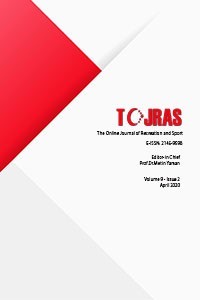THE COMPARISON OF PHYSIOLOGICAL AND MOTORIC CHARACTERISTICS OF U16-U18 BASKETBALL PLAYERS ACCORDING TO THEIR PLAYING POSITIONS
THE COMPARISON OF PHYSIOLOGICAL AND MOTORIC CHARACTERISTICS OF U16-U18 BASKETBALL PLAYERS ACCORDING TO THEIR PLAYING POSITIONS
___
- Abdelkrim, N., Fazaa, S., Ati, J. (2007). Time motion analysis and physiological data of elite under-19-year-old basketball players during competition. British Journal of Sports Medicine, 41: 69-75.
- Atan, T., Akyol, P., Çebi, M. (2013). Comparison of respiratory functions of athletes engaged in different individual sports branches. Dicle Medical Journal, 40(2):192-8.
- Bavlı, Ö.(2008). Adölesan Dönem Basketbolcularda Mevkilere Göre Yapısal ve Motorik Özelliklerin Karşılaştırılması. Niğde Üniversitesi Beden Eğitimi ve Spor Bilimleri Dergisi, 2(3);174-181.
- Delextrat, A., Cohen, D. (2009). Strength, power, speed, and agility of women basketball players according to playing position. Journal of Strength and Conditioning Research, 23(7): 1974-1981.
- Erculj, F., Blas, M. and Bracic, M. (2010). Physical demands on young elite European female basketball players with special reference to speed, agility, explosive strength, and take- off power. J Strength Cond Res,24(11): 2970-2978.
- Erdil, G., Durusoy, F., İşleğen, Ç., Yolaz, G. (1984). Elit masa tenisçilerinin fiyolojik kapasite ölçümleri. Spor Hekimliği Dergisi, 19: 15-22.
- Greene, JJ. et al., (1998). Anthropometric and performance measures for high school basketball players. Journal of Athletic Training, 33(3), 229-232.
- Kızılet, A., Atılan, O., Erdemir, İ. (2010). 12-14 Yaş grubu basketbol oyuncularının çabukluk ve sıçrama yetilerine farklı kuvvet antrenmanlarının etkisi. ATABESBD, 12(2), 44- 57.
- Macura, P. et al., (2013). Zápasové vnştorné zaťaženie basketbalistov podľa hráčskych funkcií. [Game inside load of different player´s posts in male basketball]. In: Zborník vedeckých prác Katedry športových hier FTVŠ UK č. 21. Bratislava: 4-17. ISBN 978-80-89257-62-1.
- McKeag, D. (2003). Basketball - Olympic handbook of sports medicine. Oxford: Blackwell Publishing.
- Meckell, Y., Casorla, T., Eliakim, A. (2009). The influence of basketball dribbling on repeated sprints. International Journal of Coaching Science, 3(2): 43-56.
- Metaxas, T., Koutlianos, N., Sendelides, T., Mandroukas, A. (2009). Preseason physiological profile of soccer and basketball players in different divisions. Journal of Strength and Conditioning Research, 23(6): 1704-1713.
- Sallet, P. et al., (2005). Physiological differences in professional basketball players as a function of playing position and level of play. The Journal of Sports Medicine and Physical Fitness, 45(3): 291-294.
- ISSN: 2146-9598
- Yayın Aralığı: Yılda 4 Sayı
- Başlangıç: 2012
- Yayıncı: METİN YAMAN
DETERMINATION OF THE PEOPLE’S SATISFACTION WHO GO TO THE ZOO FOR RECREATIONAL ACTIVITY
THE RELATIONSHIP BETWEEN UNIVERSITY STUDENTS’ FREE TIME MANAGEMENT AND ACADEMIC SUCCES
Emrah SERDAR, Duygu Harmandar DEMİREL, Mehmet DEMİREL, Veli Ozan ÇAKIR
AN EVALUATION OF TURKISH POLICE OFFICER’S VIEW ON VIOLENCE IN FOOTBALL AND HOOLIGANISM
Ercan ZORBA, T Osman MUTLU, Akan BAYRAKDAR
ANALAZING THE EFFECTS OF PLATELET ON THE DURABILITY TRAINING
ANALYZING OF THE EXCERCISE ADDICTION IN INDIVUALS ENGAGED WITH INDIDIVDUAL AND TEAM SPORTS
ANALYSING WOMAN FOOTBALLERS^SOME PHYSICAL RATES ACCORDING TO THEIR PLAYING POSITIONS AND AGES
Kenan UZUN, Bekir MENDEŞ, Ayhan TEPE
